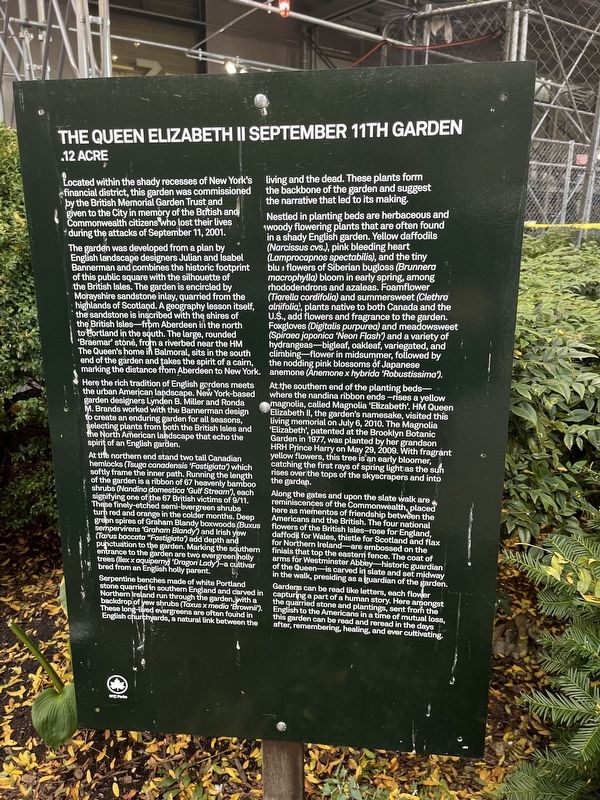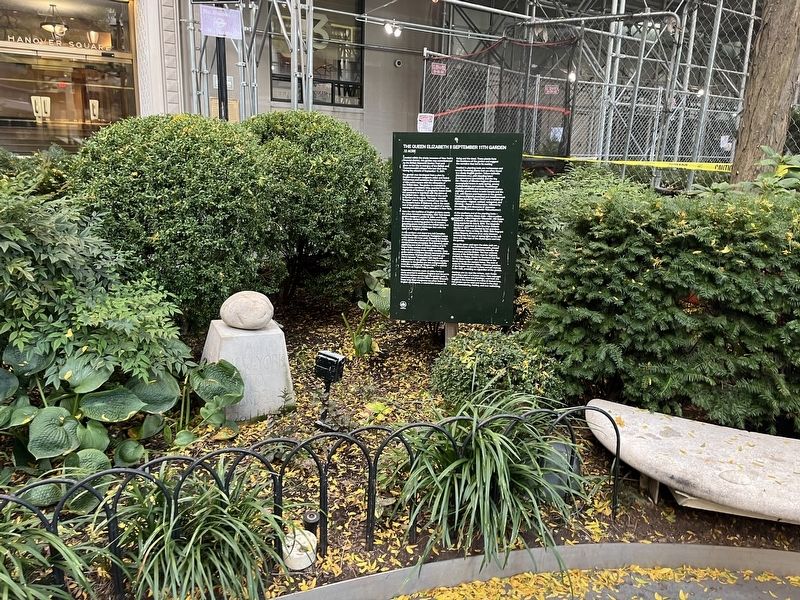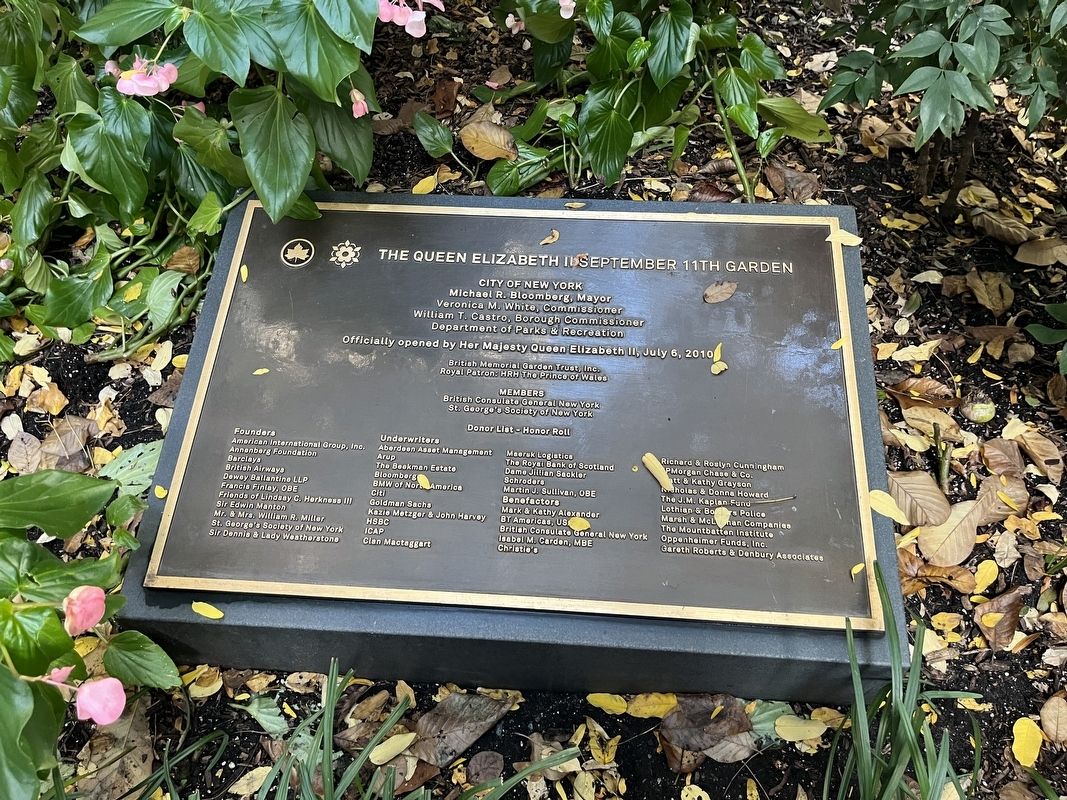Financial District in Manhattan in New York County, New York — The American Northeast (Mid-Atlantic)
The Queen Elizabeth II September 11th Garden
.12 Acre

Photographed By Devry Becker Jones (CC0), November 4, 2022
1. The Queen Elizabeth II September 11th Garden Marker
Located within the shady recesses of New York's financial district, this garden was commissioned by the British Memorial Garden Trust and given to the City in memory of the British and Commonwealth citizens who lost their lives during the attacks of September 11, 2001.
The garden was developed from a plan by English landscape designers Julian and Isabel Bannerman and combines the historic footprint of this public square with the silhouette of the British Isles. The garden is encircled by Morayshire sandstone inlay, quarried from the highlands of Scotland. A geography lesson itself, the sandstone is inscribed with the shires of the British Isles—from Aberdeen in the north to Fortland in the south. The large, rounded 'Braemar' stone, from a riverbed near the HM The Queen's home in Balmoral, sits in the south end of the garden and takes the spirit of a calm, marking the distance from Aberdeen to New York.
,br> Here the rich tradition of English gardens meets the urban American landscape. New York-based garden designers Lynden B. Miller and Ronda M. Brands worked with the Bannerman design to create an enduring garden for all seasons, selecting plants from both the British Isles and the North American landscape that echo the spirit of an English garden.
At the northern end stand two tall Canadian hemlocks (Tsuga canadensis 'Fastigiata') which softly frame the inner path. Running the length of the garden is a ribbon of 67 heavenly bamboo shrubs (Nandina domestica 'Gulf Stream'), each signifying one of the 67 British victims of 9/11. These finely-etched semi-evergreen shrubs turn red and orange in the colder months. Deep green spires of Graham Blandy boxwoods (Buxus sempervirens 'Graham Blandy') and Irish yew (Taxus baccata "Fastigiata') add depth and punctuation to the garden. Marking the southern entrance to the garden are two evergreen holly trees (Ilex x aquipernyl 'Dragon Lady')—a cultivar bred from an English holly parent.
Serpentine benches made of white Portland stone quarried in southern England and carved in Northern Ireland run though the garden, with a backdrop of yew shrubs (Taxus x media 'Brownii'). These long-lived evergreens are often found in English churchyards, a natural link between the living and the dead. These plants form the backbone of the garden and suggest the narrative that led to its making.
Nestled in planting beds are herbaceous and woody flowering plants that are often found in a shady English garden. Yellow daffodils (Narcissus cvs.), pink bleeding heart (Lamprocapnos spectabilis), and the tiny blue flowers of Siberian bugloss (Brunnera macrophylla) bloom

Photographed By Devry Becker Jones (CC0), November 4, 2022
2. The Queen Elizabeth II September 11th Garden Marker
At the southern end of the planting beds—where the nandina ribbon ends—rises a yellow magnolia, called Magnolia 'Elizabeth.' HM Queen Elizabeth II, the garden's namesake, visited this living memorial on July 6, 2010. The Magnolia 'Elizabeth,' patented at the Brooklyn Botanic Garden in 1977, was planted by her grandson HRH Prince Harry on May 29, 2009. With fragrant yellow flowers, this tree is an early bloomer, catching the first rays of spring light as the sun rises over the tops of the skyscrapers and into the garden.
Along the gates and upon the slate walk are reminiscences of the Commonwealth, placed here as mementos of friendship between the Americans and the British. The four national flowers of the British Isles—rose for England, daffodil for Wales, thistle for Scotland and flax for Northern Ireland—are embossed on the finials that top the eastern fence. The
Gardens can be read like letters, each flower capturing a part of a human story. Here amongst the quarried stone and plantings, sent from the English to the Americans in a time of mutual loss, this garden can be read and reread in the days after, remembering, healing, and ever cultivating.
Erected by NYC Parks.
Topics. This historical marker is listed in these topic lists: 9/11 Attacks • Horticulture & Forestry • Parks & Recreational Areas • Peace. A significant historical date for this entry is May 29, 2009.
Location. 40° 42.285′ N, 74° 0.577′ W. Marker is in Manhattan, New York, in New York County. It is in the Financial District. Marker is on Hanover Square north of Pearl Street, on the right when traveling north. Touch for map. Marker is at or near this postal address: 1 Hanover Square, New York NY 10004, United States of America. Touch for directions.
Other nearby markers. At least 8 other markers are within walking distance of this marker. The Cotton Exchange (a few steps from this marker); India House / British Memorial Garden in Hanover Square (within shouting distance of this marker); Delmonico's Building (within shouting distance of this marker); 57 Stone Street (within shouting distance of this marker); 13 South William Street (within shouting distance of this marker); First Printing Press in the Colony of New York (about 300 feet away, measured in a direct line); Stone Street Historic District (about 400 feet away); First Precinct Police Station (about 400 feet away). Touch for a list and map of all markers in Manhattan.
Related marker. Click here for another marker that is related to this marker. This marker has replaced the linked marker.
Credits. This page was last revised on January 31, 2023. It was originally submitted on November 6, 2022, by Devry Becker Jones of Washington, District of Columbia. This page has been viewed 105 times since then and 22 times this year. Photos: 1, 2, 3. submitted on November 6, 2022, by Devry Becker Jones of Washington, District of Columbia.
